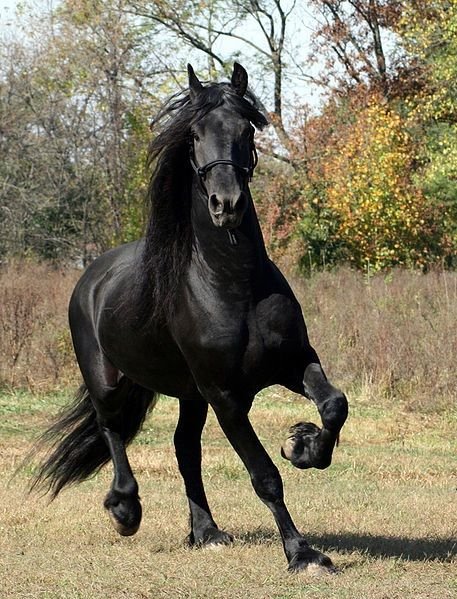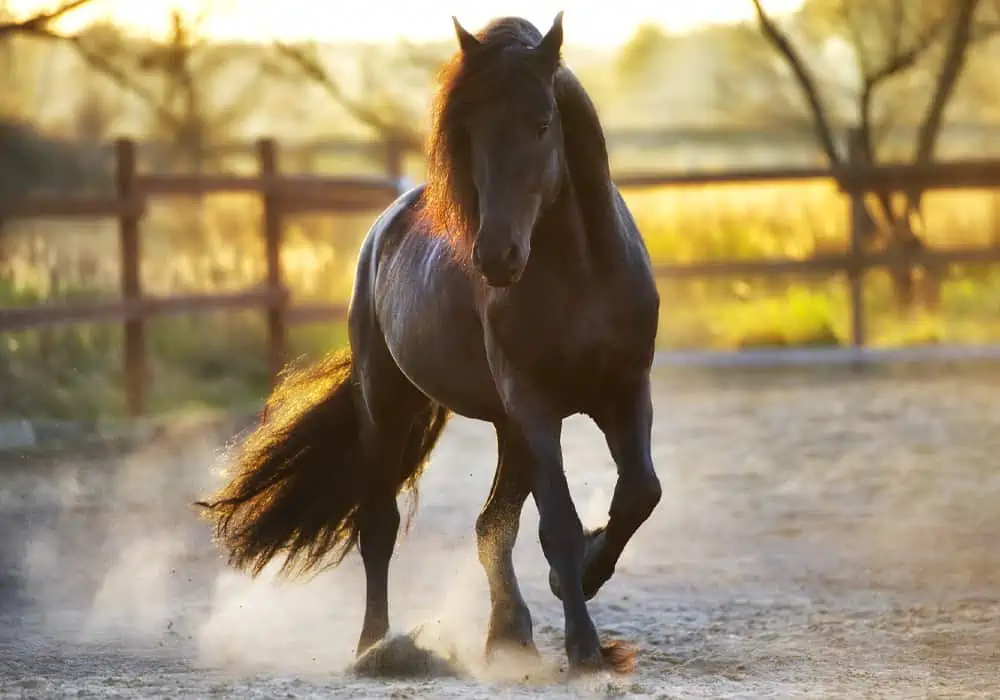
The beautiful Friesian horse takes its name from Friesland in Holland (The Netherlands). The Friesian is one of Europe’s most ancient equine breeds – a horse with truly versatile talents and the smarts to match.
Friesian horses are not always easy to come by and their designation within the equine community as “dream” or “fairytale” horses gives an indication of the price range for a purebred Friesian.
In this article, we explore what goes into setting a Friesian horse price as well as reviewing other one-time and ongoing horse care expenses.
Contents
Friesian Horse Purchase Price
The purchase price for a purebred, pedigreed, FHANA-inspected, and approved Friesian horse with a special designation can range from $19,900 upwards to $47,900 and greater.
Friesians that are younger, older or lack a special designation may cost less. Prices can range from just $3,000 for a trained mare in mid-life, $5,000 for a senior mare to $6,000 for a three-year-old gelding.
Factors Affecting Friesian Horse Purchase Price
These are the most common factors that can affect the Friesian horse purchase price:
- Relative breed rarity
The reason this is important to know is because true Friesian horses are fairly rare in the United States (8,000 registered) and worldwide (37,000). Ask to see papers to verify that the horse you are purchasing is a true purebred Friesian.
- Special designation
If the Friesian horse you want has earned a special studbook designation, the price typically increases accordingly.
- Temperament
There are three basic designations for horses: cold-blooded, warm-blooded, and hot-blooded. This doesn’t have anything to do with their actual temperature but rather relates to temperament.
Cold-blooded horses are typically larger draft horses bred specifically for a very calm personality.
Warm-blooded horses, which includes most Friesians, are crosses between hot-blooded and cold-blooded horses. Their temperaments are typically people-centric and athletic.
- Type of Friesian
There are two main types of Friesian purebred horses: sport and baroque. Some breeders say there is also a third, newer type; the modern Friesian.
The sport and modern may command higher prices than the old-school baroque one.
The baroque is the closest to the original Friesian warhorses. Bulky with shorter legs and a thicker appearance – these are the workhorses of the Friesians.
The sport is a leaner, often taller, more athletic, and showy Friesian that is particularly popular in dressage and for leisure riding.
The newest Friesian – the modern, is lighter, leaner, quick, and graceful and is quite popular for racing and drawing carriages.
- Gender
For true Friesian enthusiasts and serious breeders, the stallion holds a special place within the breed and often commands a higher price than either a mare or a gelding (neutered male).
- Size
According to the official FPS standard, a Friesian stallion must stand 15.3 hands (16.0 meters) tall by the horse’s first birthday. A mare must stand 14.3 hands (1.5 meters).
Friesians of either gender that meet this standard will often be priced higher.
The ones standing 15.25 to 16 hands represent the breed ideal and will often be priced higher than taller or shorter horses.
Be aware that dwarf Friesian horses have been bred in the past and sold to unaware owners. Dwarfism is actually caused by a known genetic mutation and can bring with it expensive, life-long health issues.
- Age
It is important to know that some health issues only occur after a horse has matured. For example, the fatal genetic condition aortic artery rupture typically occurs at age four or later.
This is important to know if you see a young purebred Friesian for sale at a price that seems “too good to be true”.
For young Friesians that have not yet reached their full adult potential or conformation, parentage can greatly influence price. Here, the younger the horse, the lower the price is likely to be.
Be sure to research bloodlines and parent’s health before making a commitment in any price range.
- Color
True Friesians are all black. The only white permitted is a small white star on the forehead. Some can look dark brown due to sun or sweat.
It is important to determine whether a lighter coat color is due to the bleaching effect of the sun or sweat or due to genetics.
Chestnut, red, and other colors of Friesian horses are called “Fire Friesians” and are classified as a heritage horse. They may have hybrid parentage and cannot be registered in the official breed studbook.
Expect to pay a lower price for these horses than for a true Friesian.
- Training
Friesian horses of any age that have been trained often command a higher price than an untrained horse.
- Breed registration
The only Friesian registries recognized worldwide are the Friesian Horse Association of North America (FHANA) and its parent organization, The Netherlands’ Friesch Paarden Stamboek (FPS).
Other registries exist, but these registries may not have the same strict standards. This is particularly important if you plan to show your Friesian.

One-time Friesian Horse Costs
These are the most common initial costs associated with purchase of a Friesian horse:
- Stable location
Because Friesian horses are relatively rare and can be hard to obtain, it is not uncommon for a new owner to import from The Netherlands. First class shipping and handling, escort by trained handlers, supervision, and quarantine care are common expenses.
- Health tests and initial veterinary exam
Reputable breeders will typically provide X-ray results, clinical exam results, blood test results, and (if required) governmental inspection results. These may be built into your purchase price or billed separately.
- Saddle
The saddle you select can greatly influence your horse’s responsiveness and enthusiasm during training. A comfortable, well-fitting saddle will benefit you both.
Expect to spend up to $3,000+ for your new saddle and shipping.
- Saddle pad
A well-fitting, comfortable saddle pad can prevent saddle chafing and keep your horse’s skin and coat in prime condition. Prices start around $75.
- Blanket
Blanketing is common to keep horses warm in cold conditions. A blanket can cost $140 and up.
- Bridle and tack
Choosing the right bridle and tack will ensure your horse is comfortable while you are riding, performing or competing together. A bridle and tack set for training or show can cost $100 and up.
Ongoing Friesian Horse Costs
These are the most widely reported ongoing care costs associated with keeping Friesian horses:
- Horse insurance
Horse insurance can be a very smart choice for a valuable horse such as a Friesian. This can cover costs associated with illness, injury, and even mortality.
The typical cost of an annual horse insurance policy is a percentage of your horse’s value, which is factored depending on breed, sale value, age and specialty. Rates range from 2.9 to 4.5 percent of that value.
- Licensing and registration
If you want to register your horse for competitions (dressage, racing, other events) you will need to pay certain fees. A dressage horse registration is around $35.
Membership in the official Friesian Horse Association of North America (FHANA) are tiered – costs range from $60 to $180 annually plus a $20 one-time administration fee.
- Farrier
Surveys of equine owners show that farrier (shoeing and hoof trims) can cost $25 to $30 per visit and up to $100 bi-monthly.
- Grooming
A horse like a Friesian with long, flowing mane and tail hair can require regular grooming and trims to look its best. Costs can range from $10 to $125+ depending on the services provided.
- Stable, pasture, transport
Building a barn and stable with hay storage for one to two horses can cost $4,000 to $12,000. If you need pasture fencing, your price will range from $1,600 to $2,500. Bedding costs $6 and up per 40 pounds.
Transportation will require a horse trailer ($16,500+) and suitable hauling vehicle $15,000 pre-owned or $35,000+ new).
- Boarding
If you need to board your horse temporarily or on an ongoing basis, the price you pay can vary depending on requested services.
Overnight board costs around $25 while partial boarding (you provide some supplies) costs $150 and up monthly. Meanwhile, full boarding (stable provides everything) costs $500 to $1,250 per month.
- Manure removal
One often-overlooked expense is dealing with horse waste. A 1,000-pound horse can easily produce 31 pounds of manure and 2.4 gallons of urine each day!
A common choice is to rent a dumpster ($200 to $900 annually depending on size) and hire a waste disposal company to empty it ($3,000 per year).
- Food and Supplements
The food you feed may vary depending on your horse’s age, gender and stage of life. Timothy hay is a staple. Expect to spend $20 and up per 50-pound bale.
It would cost anywhere from $8 to $30 and up per 40-pound bag of nutritional supplement. For joint support (important for senior horses) prices start around $100 for a 30-day supply.
- Training
Training costs can vary depending on the goal. Expect to spend $45 to $80 per hour to hire a professional horse trainer depending on what type of training you and your horse need.
- Dental
Annual costs for equine dental care range from $100 to $250+ depending on your horse’s age.
- Veterinary
A critical part of maintaining such a valuable pet is health care. How much you keep it healthy spells difference in its lifespan. Losing a pet horse worth almost $50,000 over an illness that could have been easily prevented by just a mere visit to your vet might not be something you will ever want to deal with.
Vaccines cost $22 to $47+ depending on type while Coggins testing (required for travel) costs $37 to $87 depending on urgency. Health certificates cost around $40 and microchipping is less than $60 on the average.
A full preventative performance exam is $230 if you want to ensure that your horse is in the pink of health and an emergency treatment starts at $145.
